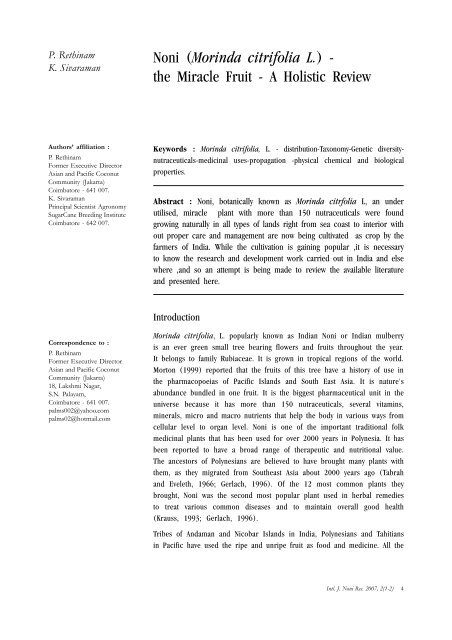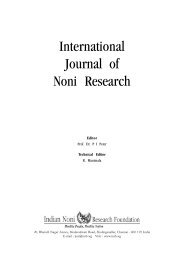International Journal of Noni Research - Noni Family
International Journal of Noni Research - Noni Family
International Journal of Noni Research - Noni Family
Create successful ePaper yourself
Turn your PDF publications into a flip-book with our unique Google optimized e-Paper software.
P. Rethinam<br />
K. Sivaraman<br />
Authors’ affiliation :<br />
P. Rethinam<br />
Former Executive Director<br />
Asian and Pacific Coconut<br />
Community (Jakarta)<br />
Coimbatore - 641 007.<br />
K. Sivaraman<br />
Principal Scientist Agronomy<br />
SugarCane Breeding Institute<br />
Coimbatore - 642 007.<br />
Correspondence to :<br />
P. Rethinam<br />
Former Executive Director<br />
Asian and Pacific Coconut<br />
Community (Jakarta)<br />
18, Lakshmi Nagar,<br />
S.N. Palayam,<br />
Coimbatore - 641 007.<br />
palms002@yahoo.com<br />
palms02@hotmail.com<br />
<strong>Noni</strong> (Morinda citrifolia L.) -<br />
the Miracle Fruit - A Holistic Review<br />
Keywords : Morinda citrifolia, L. - distribution-Taxonomy-Genetic diversitynutraceuticals-medicinal<br />
uses-propagation -physical chemical and biological<br />
properties.<br />
Abstract : <strong>Noni</strong>, botanically known as Morinda citrfolia L, an under<br />
utilised, miracle plant with more than 150 nutraceuticals were found<br />
growing naturally in all types <strong>of</strong> lands right from sea coast to interior with<br />
out proper care and management are now being cultivated as crop by the<br />
farmers <strong>of</strong> India. While the cultivation is gaining popular ,it is necessary<br />
to know the research and development work carried out in India and else<br />
where ,and so an attempt is being made to review the available literature<br />
and presented here.<br />
Introduction<br />
Morinda citrifolia, L. popularly known as Indian <strong>Noni</strong> or Indian mulberry<br />
is an ever green small tree bearing flowers and fruits throughout the year.<br />
It belongs to family Rubiaceae. It is grown in tropical regions <strong>of</strong> the world.<br />
Morton (1999) reported that the fruits <strong>of</strong> this tree have a history <strong>of</strong> use in<br />
the pharmacopoeias <strong>of</strong> Pacific Islands and South East Asia. It is nature's<br />
abundance bundled in one fruit. It is the biggest pharmaceutical unit in the<br />
universe because it has more than 150 nutraceuticals, several vitamins,<br />
minerals, micro and macro nutrients that help the body in various ways from<br />
cellular level to organ level. <strong>Noni</strong> is one <strong>of</strong> the important traditional folk<br />
medicinal plants that has been used for over 2000 years in Polynesia. It has<br />
been reported to have a broad range <strong>of</strong> therapeutic and nutritional value.<br />
The ancestors <strong>of</strong> Polynesians are believed to have brought many plants with<br />
them, as they migrated from Southeast Asia about 2000 years ago (Tabrah<br />
and Eveleth, 1966; Gerlach, 1996). Of the 12 most common plants they<br />
brought, <strong>Noni</strong> was the second most popular plant used in herbal remedies<br />
to treat various common diseases and to maintain overall good health<br />
(Krauss, 1993; Gerlach, 1996).<br />
Tribes <strong>of</strong> Andaman and Nicobar Islands in India, Polynesians and Tahitians<br />
in Pacific have used the ripe and unripe fruit as food and medicine. All the<br />
Intl. J. <strong>Noni</strong> Res. 2007, 2(1-2) 4








